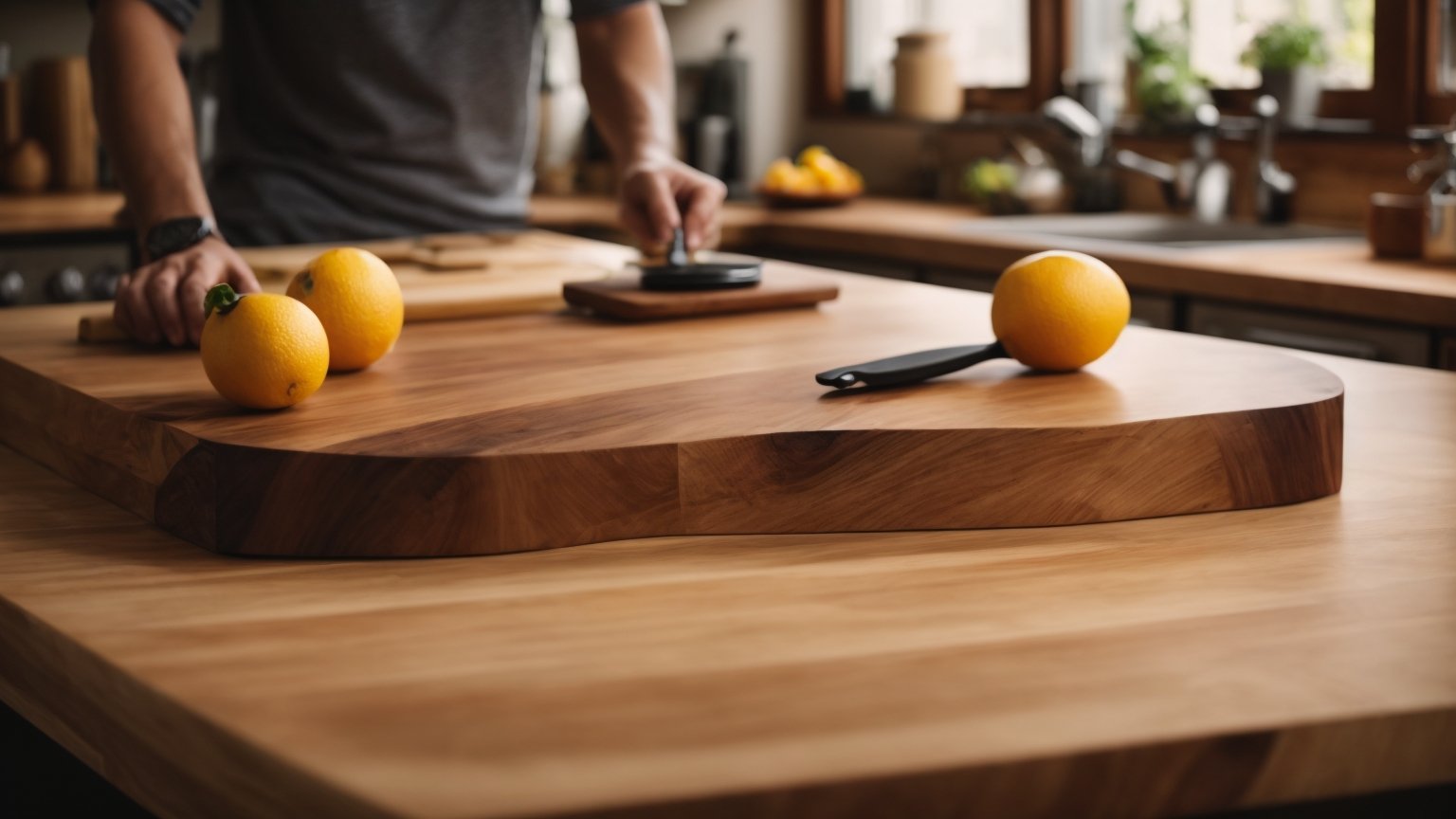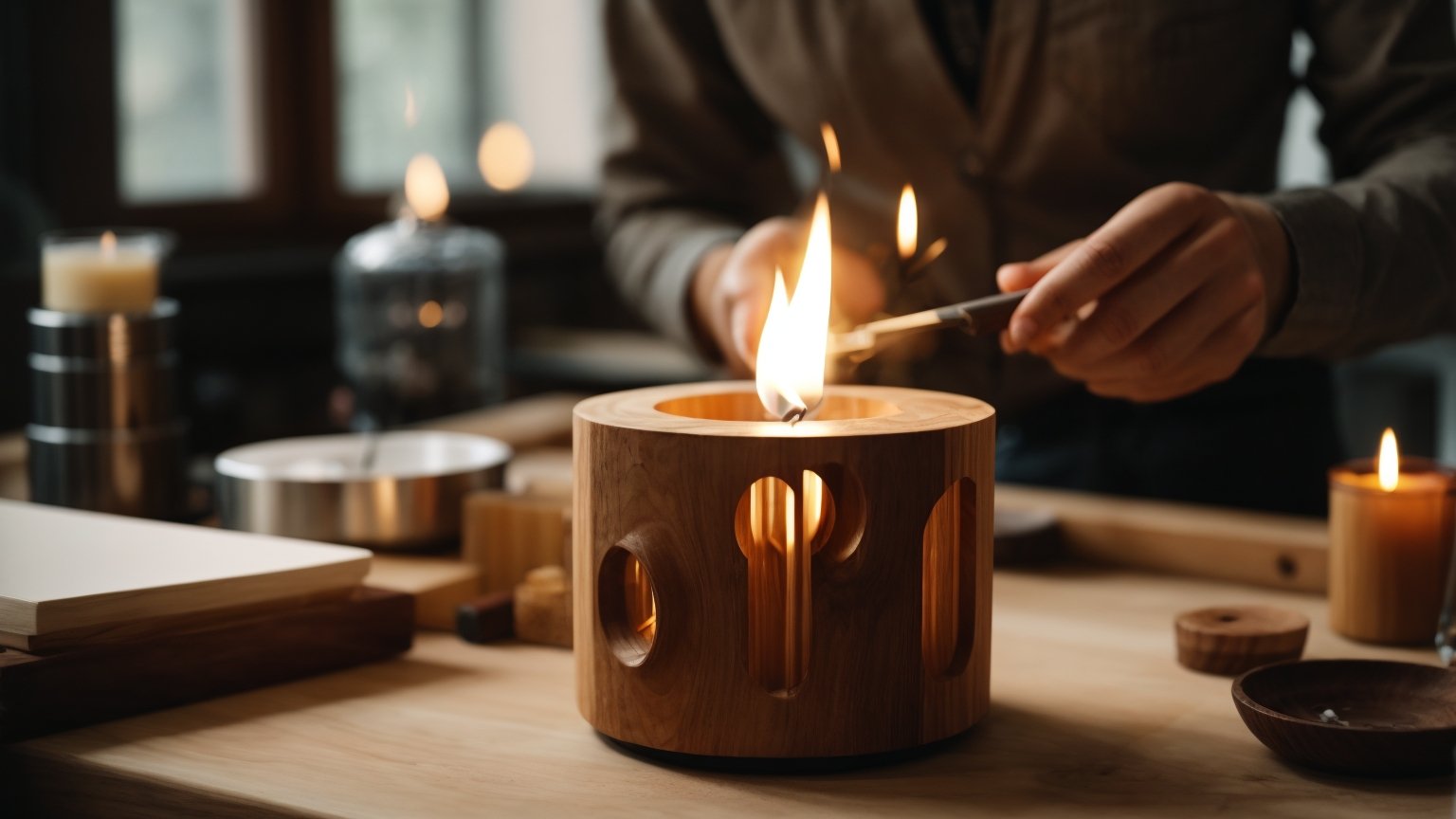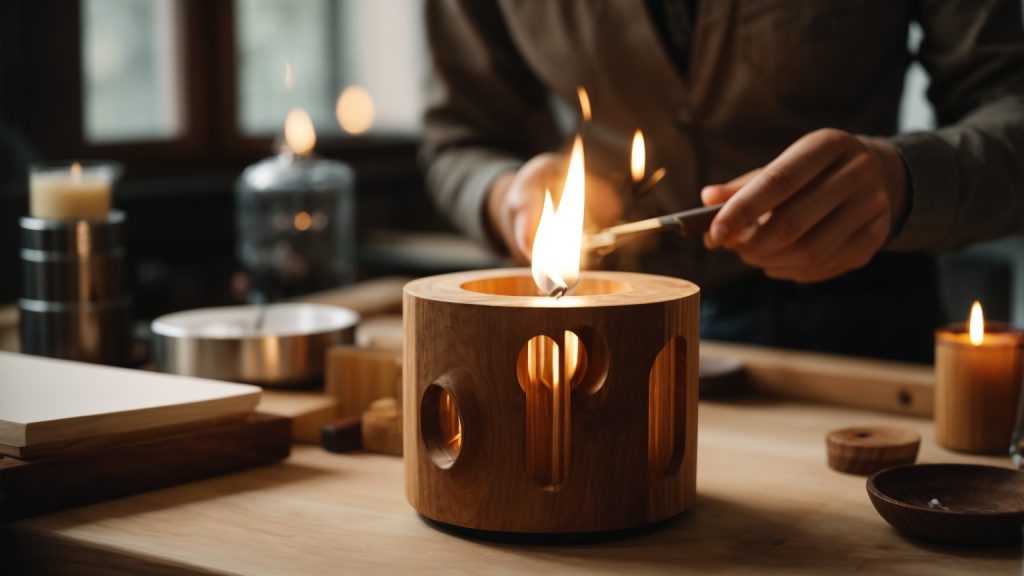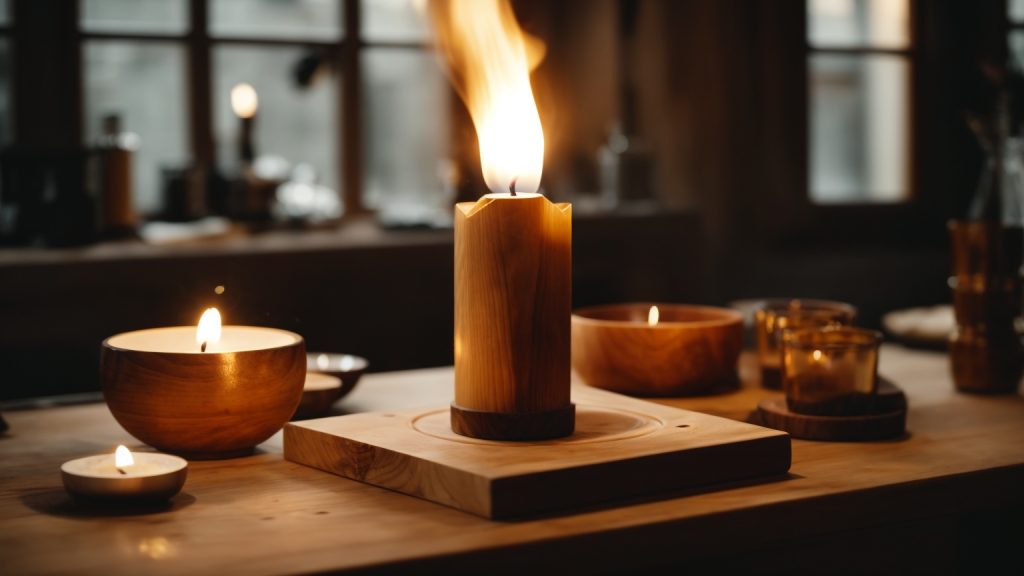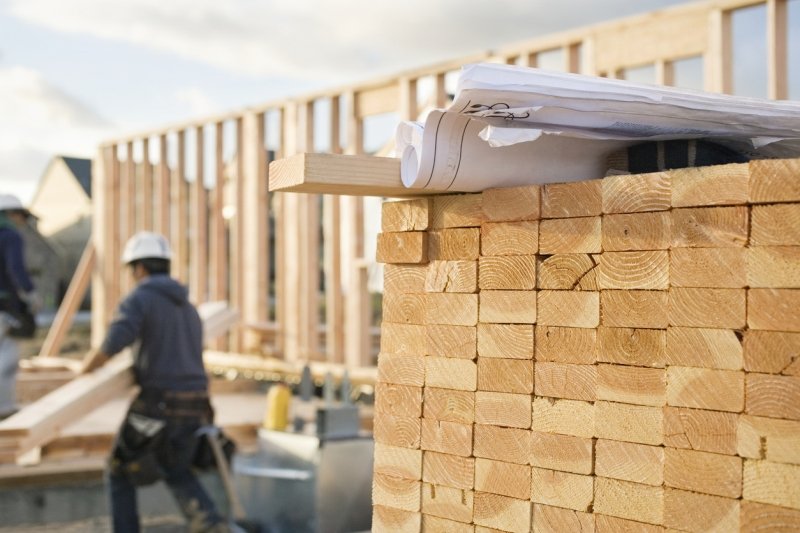If you’re looking to add some warmth and character to your kitchen, a wooden countertop can be a great choice. However, to keep it looking beautiful and functional, you need to properly finish it. In this article, we’ll guide you through the steps to finish a wooden countertop, so you can enjoy it for years to come.
First, it’s important to gather the necessary materials. You’ll need fine-grit sandpaper, staining pads or rags, wood stain, protective gloves, safety glasses, a paintbrush or foam brush, polyurethane, clean, lint-free cloths, and a tack cloth. Once you have all of your materials, you can begin the process of finishing your wooden countertop.
The first step is to sand the countertop with the fine-grit sandpaper until it’s smooth to the touch. Then, use the tack cloth to remove any dust or debris. Next, apply the wood stain with the staining pads or rags, following the manufacturer’s instructions. Once the stain has dried, apply a coat of polyurethane with the paintbrush or foam brush, and let it dry completely. Repeat this process until you’ve achieved the desired level of protection and sheen. With these steps, you can finish your wooden countertop and enjoy its natural beauty.
Understanding Wood Types for Countertops
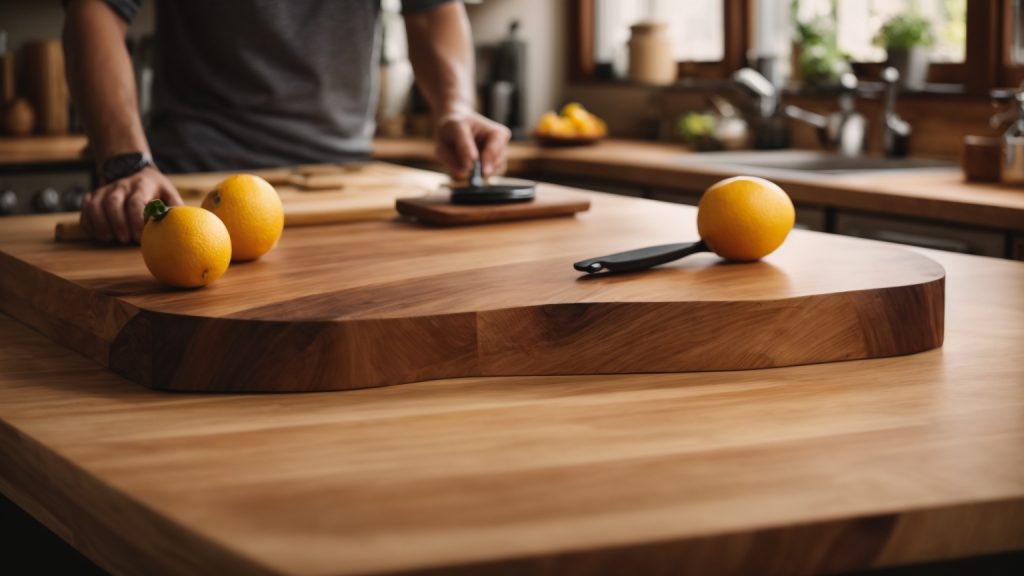
When it comes to choosing the right wood for your countertop, it’s important to consider both aesthetics and functionality. Different types of wood have varying levels of hardness, durability, and resistance to moisture and stains. Here are some common wood types used for countertops:
1. Maple
Maple is a popular choice for countertops due to its durability and resistance to wear and tear. It has a light, uniform color and a fine, even grain pattern. Maple is also relatively affordable compared to other hardwoods.
2. Cherry
Cherry is a beautiful, warm-toned wood with a rich, reddish-brown color that darkens over time. It has a fine, straight grain pattern and is known for its durability and resistance to moisture. Cherry is a more expensive option than maple, but it adds a luxurious feel to any kitchen.
3. Walnut
Walnut is a darker wood with a rich, chocolate brown color and a swirling grain pattern. It is a softer wood than maple or cherry, but it is still durable and resistant to moisture. Walnut is a more expensive option, but it adds a unique and sophisticated look to any kitchen.
4. Oak
Oak is a classic choice for countertops with its distinctive grain pattern and warm, golden color. It is a hard, durable wood that is resistant to moisture and stains. Oak is a more affordable option than some other hardwoods, but it still adds a timeless look to any kitchen.
5. Teak
Teak is a tropical hardwood with a warm, golden color and a distinctive grain pattern. It is extremely durable and resistant to moisture, making it a popular choice for outdoor kitchens. Teak is one of the most expensive wood options, but it adds a luxurious feel to any kitchen.
When choosing a wood for your countertop, consider the level of maintenance required to keep it in good condition. Some woods may require more frequent oiling or sealing to prevent damage from moisture and stains. Ultimately, the right wood for your countertop will depend on your personal preferences and the specific needs of your kitchen.
Choosing the Right Wood
When it comes to choosing the right wood for your countertop, there are several factors to consider. Here are some things to keep in mind:
Durability
First and foremost, you want a wood that is durable enough to withstand daily use. Hardwoods like oak, maple, and cherry are popular choices for this reason. They are strong and can handle the wear and tear of a busy kitchen.
Appearance
Of course, you also want your countertop to look good. Different woods have different colors, grains, and textures, so choose one that complements your kitchen’s style. For example, if you have a modern kitchen with stainless steel appliances, you might opt for a sleek, pale wood like birch or ash.
Cost
Wood countertops can be expensive, so you’ll want to consider the cost of the wood you choose. Some woods, like teak or mahogany, can be quite pricey, while others, like pine or poplar, are more affordable.
Sustainability
Finally, it’s important to consider the environmental impact of the wood you choose. Look for woods that are sustainably sourced and certified by organizations like the Forest Stewardship Council (FSC). These woods are harvested in a way that protects the environment and ensures that forests will be around for future generations.
By considering these factors, you can choose a wood that not only looks great but also meets your practical needs and values.
Preparation of the Wood Surface
Before you start finishing your wooden countertop, it is essential to prepare the wood surface properly. Proper preparation will ensure that the finish adheres well to the wood surface and gives you a smooth, even finish. Here are some steps to follow:
Sanding the Wood Surface
The first step in preparing the wood surface is sanding. Sanding the wood surface will remove any roughness, scratches, or stains and create a smooth surface for the finish. Here are some tips for sanding your wooden countertop:
- Start with a coarse-grit sandpaper, such as 80 grit, and work your way up to a finer-grit sandpaper, such as 220 grit.
- Sand in the direction of the wood grain to avoid creating scratches.
- Use a sanding block or an orbital sander to ensure even sanding.
After sanding, use a tack cloth to remove any dust or debris from the surface.
Applying Wood Stain
If you want to stain your wooden countertop, you should do it after sanding and before applying the finish. Here are some tips for applying wood stain:
- Wear protective gloves and safety glasses.
- Use a staining pad or a rag to apply the stain evenly.
- Apply the stain in the direction of the wood grain.
- Wipe off any excess stain with a clean, lint-free cloth.
Allow the stain to dry completely before applying the finish.
Applying the Finish
The final step in preparing the wood surface is applying the finish. Here are some tips for applying the finish:
- Choose the right finish for your wooden countertop. Polyurethane is a popular choice for countertops because it is durable and water-resistant.
- Apply the finish in thin, even coats using a brush or a foam brush.
- Allow each coat to dry completely before applying the next coat.
- Sand lightly between coats with a fine-grit sandpaper, such as 220 grit.
- Apply at least two coats of finish for best results.
By properly preparing the wood surface, you will ensure that your wooden countertop looks beautiful and lasts for years to come.
Cutting and Shaping the Countertop
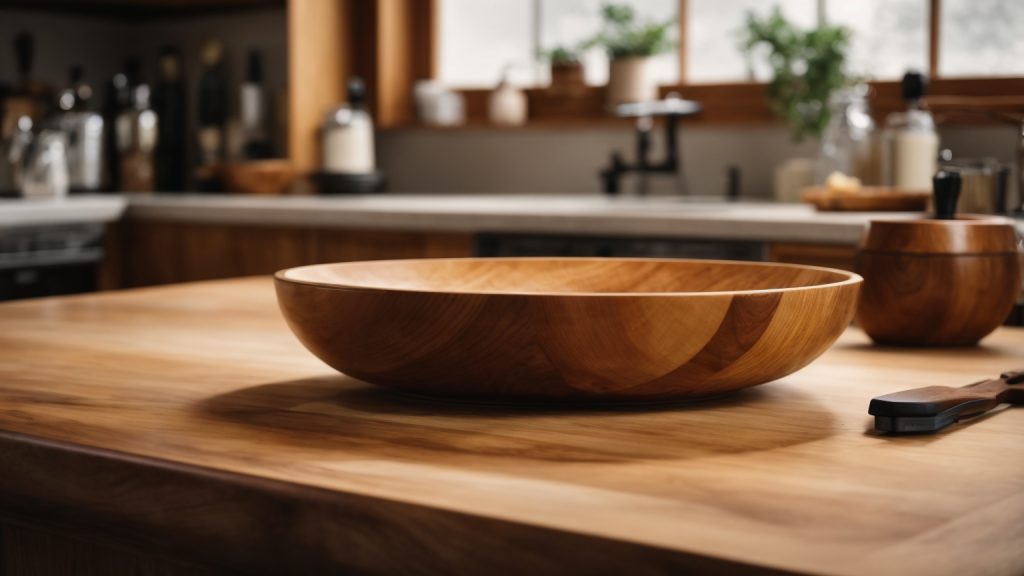
Before you start finishing your wooden countertop, you need to cut and shape it according to your desired size and design. Here are some tips to help you with this process:
1. Measure and Mark
First, measure the area where you want to install the countertop. Use a measuring tape to get accurate measurements. Then, mark the measurements on the wooden board where you want to cut. Use a straight edge to ensure that your marks are straight and even.
2. Cut the Countertop
Next, use a circular saw or a jigsaw to cut the countertop along the marked lines. Make sure to wear safety goggles and gloves to protect yourself from flying debris. If you are using a jigsaw, start by drilling a hole in the wood along the cut line. Then, insert the jigsaw blade into the hole and start cutting.
3. Sand the Edges
After cutting the countertop, use a belt sander or an orbital sander to smooth out the edges. Start with a coarse grit sandpaper and gradually move to a finer grit. Sand in the direction of the wood grain to avoid damaging the wood.
4. Shape the Countertop
If you want to shape the countertop, use a router to create the desired edges and curves. You can also use a chisel to create decorative details. Make sure to sand the shaped areas to smooth out any rough edges.
5. Clean the Countertop
Finally, clean the countertop with a tack cloth to remove any sawdust or debris. This will ensure that the wood is clean and ready for the finishing process.
By following these steps, you can cut and shape your wooden countertop to your desired size and design.
Sanding the Wood
When it comes to finishing a wooden countertop, sanding is a crucial step that can make or break the final result. Here are some tips to help you sand your wooden countertop like a pro:
- Start with coarse sandpaper: Begin by using a coarse sandpaper, such as 60 or 80 grit, to remove any roughness or imperfections on the surface of the wood. Use a belt sander or orbit sander to make the job easier and faster.
- Switch to finer grits: Once you have removed the roughness, switch to finer grits, such as 120, 220, or 320 grit, to create a smooth surface. Be sure to sand evenly and consistently, and avoid applying too much pressure that can cause unevenness or scratches.
- Sand with the grain: Always sand with the grain of the wood, not against it, to avoid creating scratches or marks that can be difficult to remove. Use a light touch and let the sandpaper do the work.
- Vacuum and wipe the surface: After sanding, vacuum the surface to remove any dust or debris, and then wipe it with a clean rag dipped in mineral spirits to remove any remaining residue. Let the surface dry completely before applying any finish.
Remember, sanding is a crucial step in finishing a wooden countertop, but it can also be time-consuming and messy. Take your time, use the right sandpaper, and follow these tips to achieve a smooth and beautiful finish that will last for years to come.
Applying a Wood Conditioner
When it comes to finishing a wooden countertop, applying a wood conditioner is an important step to ensure a smooth and even stain application. A wood conditioner is a type of pre-stain treatment that helps to prepare the wood surface for staining. It helps to prevent blotchiness and uneven absorption of the stain.
To apply a wood conditioner, you will need to follow these simple steps:
- Sand the surface of the wood with low-grit sandpaper to ensure solid absorption of the wood conditioner. Sanding the wood by hand should be more than sufficient for proper absorption. You should also ensure there’s no other residue on the surface of the wood.
- Liberally apply the wood conditioner with a brush, roller, or cloth. Make sure to apply the conditioner in the direction of the grain.
- Let the conditioner sit on the wood surface for the recommended time specified by the manufacturer. Typically, this is between 5-15 minutes.
- After the recommended time has passed, wipe off any remaining wood conditioner with a clean cloth. Make sure to remove all excess conditioner from the surface of the wood.
- Wait for the wood to dry completely before applying the stain. It’s important to apply the stain within two hours of applying the wood conditioner to ensure optimal results.
By applying a wood conditioner before staining your wooden countertop, you can ensure that the stain will be absorbed evenly and prevent blotchiness. It’s an easy step that can make a big difference in the final appearance of your countertop.
Staining the Wood
Staining the wood is a crucial step in finishing a wooden countertop. It adds color and depth to the wood, enhancing its natural beauty. Here are some tips on how to stain a wooden countertop:
Step 1: Sand the Wood
Before you start staining, make sure the wood is sanded properly. Sanding removes any rough patches or imperfections, allowing the stain to penetrate the wood evenly. Start with a coarse-grit sandpaper and gradually work your way up to a finer grit. Once you’ve sanded the wood, wipe it down with a tack cloth to remove any dust or debris.
Step 2: Choose the Right Stain
Choosing the right stain is important to achieve the desired color and finish. There are two types of stain: oil-based and water-based. Oil-based stains penetrate deeper into the wood, resulting in a richer color. Water-based stains dry faster and are easier to clean up. Consider the type of wood you’re working with and the look you’re trying to achieve when choosing a stain.
Step 3: Apply the Stain
Apply the stain using a staining pad or rag, working with the grain of the wood. Start with a small section and work your way across the entire countertop. Make sure to apply the stain evenly and wipe off any excess with a clean cloth. Allow the stain to dry completely before moving on to the next step.
Step 4: Seal the Wood
Once the stain has dried, it’s time to seal the wood. This protects the wood from moisture and wear and tear. There are several types of sealers to choose from, including polyurethane, varnish, and shellac. Apply the sealer using a brush or roller, working with the grain of the wood. Allow the sealer to dry completely before using the countertop.
Staining a wooden countertop is a great way to add character and warmth to your kitchen. With the right tools and techniques, you can achieve a beautiful finish that will last for years to come.
Sealing the Countertop
After sanding and staining your wooden countertop, the next step is to seal it. Sealing the countertop will protect it from moisture, stains, and scratches, and it will also enhance the natural beauty of the wood. In this section, we will discuss how to choose the right sealer and how to apply it.
Choosing the Right Sealer
When it comes to choosing a sealer for your wooden countertop, there are several options available. Here are some of the most popular ones:
- Polyurethane: Polyurethane is a popular choice for sealing wooden countertops because it provides a durable and long-lasting finish. It comes in both oil-based and water-based formulas, and it can be applied with a brush, roller, or sprayer. However, polyurethane can give the wood a plastic-like appearance, which may not be desirable for some homeowners.
- Tung oil: Tung oil is a natural oil that penetrates the wood and provides a protective finish. It is easy to apply, dries quickly, and gives the wood a warm, natural look. However, tung oil is not as durable as polyurethane, and it may need to be reapplied every few years.
- Danish oil: Danish oil is a blend of natural oils and varnish that provides a protective finish and enhances the natural beauty of the wood. It is easy to apply, dries quickly, and gives the wood a warm, natural look. However, like tung oil, Danish oil is not as durable as polyurethane, and it may need to be reapplied every few years.
When choosing a sealer for your wooden countertop, consider the level of durability you need, the desired appearance, and the ease of application.
Applying the Sealer
Before applying the sealer, make sure the countertop is clean and free of dust. You can use a tack cloth or a vacuum to remove any dust or debris.
To apply the sealer, follow these steps:
- Prepare the sealer: If you are using a polyurethane sealer, make sure to stir it well before use. If you are using an oil-based sealer, you may need to thin it with mineral spirits. Read the manufacturer’s instructions carefully before use.
- Apply the sealer: Using a brush, roller, or sprayer, apply a thin, even coat of the sealer to the countertop. Make sure to work in the direction of the grain. Avoid over-applying the sealer, as this can lead to drips and bubbles.
- Let the sealer dry: Allow the sealer to dry according to the manufacturer’s instructions. This may take several hours or overnight.
- Sand the countertop: Once the sealer is dry, lightly sand the countertop with a fine-grit sandpaper. This will help the next coat of sealer adhere better.
- Apply additional coats: Apply additional coats of sealer as needed, following the same process as above. Most sealers require at least two coats for adequate protection.
By following these steps, you can seal your wooden countertop and protect it for years to come.
Maintaining Your Wooden Countertop
Wooden countertops are a beautiful addition to any kitchen, but they require a bit of maintenance to keep them looking their best. Here are some tips to help you maintain your wooden countertop:
Regular Cleaning
The most important thing you can do to maintain your wooden countertop is to clean it regularly. You should wipe down the surface with a damp cloth after each use, and then dry it with a clean towel. Avoid using harsh chemicals or abrasive sponges, as these can damage the wood.
Periodic Re-Sealing
To keep your wooden countertop looking its best, you should re-seal it periodically. This will help to protect the wood from moisture and stains. The frequency with which you need to re-seal your countertop will depend on the type of wood and the amount of use it gets. As a general rule, you should re-seal your countertop every six months to a year.
To re-seal your countertop, follow these steps:
- Sand the surface of the countertop with fine-grit sandpaper.
- Wipe the surface clean with a tack cloth.
- Apply a thin coat of wood sealer with a staining pad or foam brush.
- Wait for the sealer to dry, then sand the surface lightly with 220-grit sandpaper.
- Wipe the surface clean with a tack cloth.
- Apply a second coat of sealer.
Avoiding Damage
Wooden countertops are susceptible to damage from heat, moisture, and sharp objects. To avoid damage, follow these tips:
- Use trivets or hot pads to protect the surface from hot pots and pans.
- Wipe up spills immediately to prevent moisture from penetrating the wood.
- Avoid cutting directly on the countertop. Use a cutting board instead.
- Do not place heavy objects on the countertop, as this can cause it to warp or crack.
By following these tips, you can keep your wooden countertop looking beautiful for years to come.
